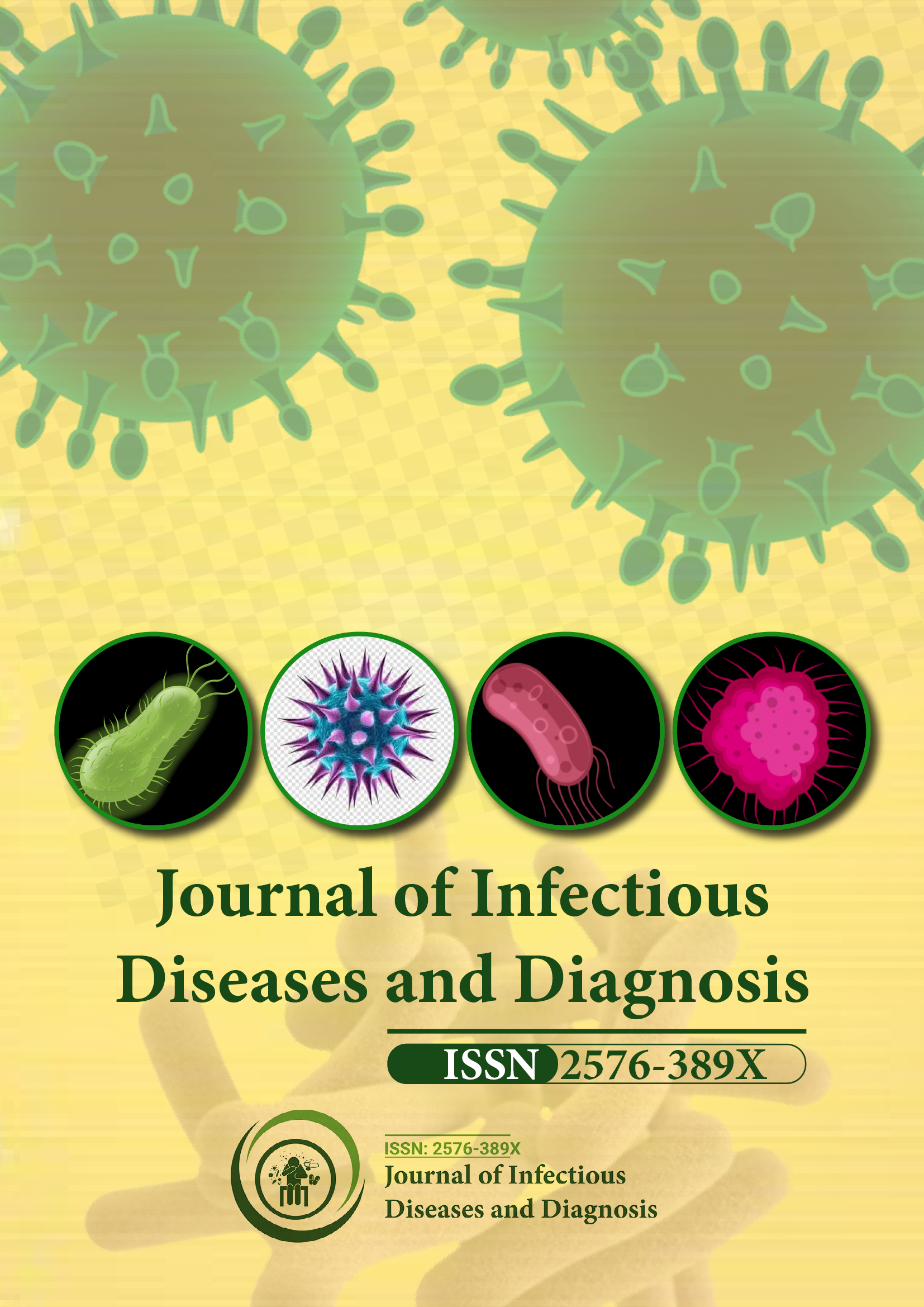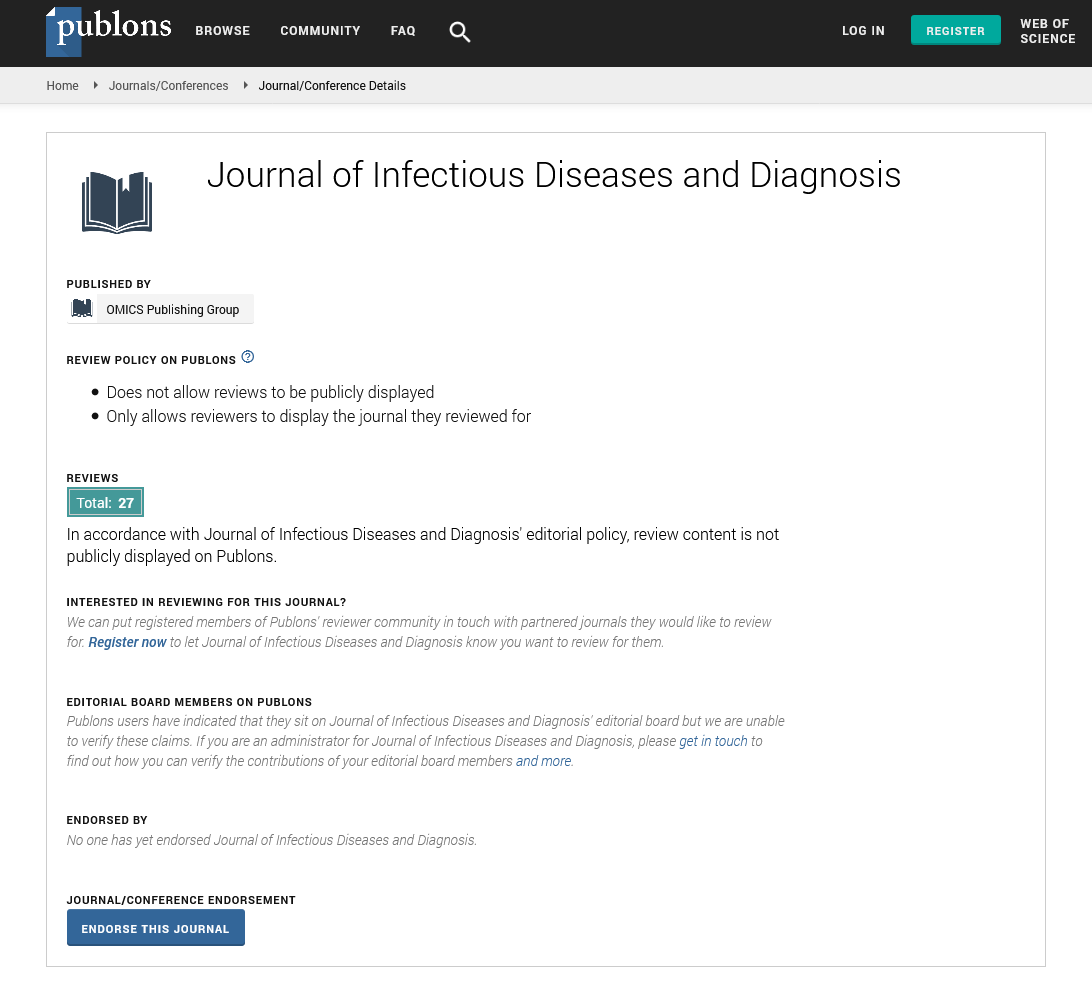Indexed In
- RefSeek
- Hamdard University
- EBSCO A-Z
- Publons
- Euro Pub
- Google Scholar
Useful Links
Share This Page
Journal Flyer

Open Access Journals
- Agri and Aquaculture
- Biochemistry
- Bioinformatics & Systems Biology
- Business & Management
- Chemistry
- Clinical Sciences
- Engineering
- Food & Nutrition
- General Science
- Genetics & Molecular Biology
- Immunology & Microbiology
- Medical Sciences
- Neuroscience & Psychology
- Nursing & Health Care
- Pharmaceutical Sciences
Short Communication - (2025) Volume 10, Issue 3
Long COVID Syndrome: A Retrospective Analysis of Persistent Symptoms and Inflammatory Markers Post SARS-CoV-2 Infection
Henry Richard**Received: 30-Apr-2025, Manuscript No. JIDD-25-29302; Editor assigned: 02-May-2025, Pre QC No. JIDD-25-29302 (PQ); Reviewed: 16-May-2025, QC No. JIDD-25-29302; Revised: 23-May-2025, Manuscript No. JIDD-25-29302 (R); Published: 30-May-2025, DOI: 10.35248/2576-389X.25.10.337
Description
Since the emergence of SARS-CoV-2, attention has primarily focused on acute infection and mortality. However, a growing body of evidence indicates that a subset of individuals continues to experience a range of persistent symptoms long after recovery from the initial illness. These symptoms, collectively referred to as Long COVID or Post-Acute Sequelae of SARS-CoV-2 infection (PASC), can affect individuals regardless of age, sex, or the severity of the acute phase. The range of complaints includes fatigue, shortness of breath, cognitive disturbances, joint pain, palpitations and emotional changes, often occurring in clusters and fluctuating over time. The pathophysiological basis remains poorly understood, but ongoing immune dysregulation and low-grade inflammation have been suggested. This retrospective analysis aimed to examine the frequency and profile of long-term symptoms in recovered COVID-19 patients and to explore the association with inflammatory biomarkers.
The study analyzed medical records and follow-up data from 860 adult patients who had tested positive for SARS-CoV-2 between April 2020 and March 2022 at a multispecialty hospital. Inclusion criteria required laboratory-confirmed infection and completion of at least one clinical follow-up visit within six months’ post-recovery. Patients with pre-existing chronic inflammatory or autoimmune conditions were excluded to reduce potential confounding. Data on demographics, comorbidities, acute disease severity, vaccination status and initial treatment were collected. Persistent symptoms reported beyond four weeks from diagnosis were classified as postacute, while those extending beyond 12 weeks were classified as long-term [1–3].
Among the 860 patients, 312 (36.2%) reported one or more lingering symptoms 12 weeks’ post-infection. Fatigue was the most commonly reported symptom, present in 68% of these individuals. Breathlessness, cognitive difficulties (commonly described as “brain fog”) and sleep disturbances were also frequent. Other symptoms included joint or muscle pain, palpitations and gastrointestinal complaints such as nausea or altered bowel habits. The average duration of these symptoms was 5.7 months, with some patients continuing to report ongoing issues even beyond a year after recovery.
Patients who had required hospitalization during their acute illness were more likely to develop persistent symptoms, but a significant proportion (28%) of long COVID cases occurred in individuals who had mild or moderate initial infections and were managed at home. Women were slightly more affected than men, particularly in the 30–55 age group [4]. Pre-existing conditions such as hypertension, obesity and type 2 diabetes were associated with a higher likelihood of symptom persistence. Interestingly, vaccinated individuals had lower rates of long-term symptoms compared to those who had not received any doses prior to infection.
Laboratory results collected during follow-up visits showed elevated levels of certain inflammatory markers in a considerable number of patients with ongoing symptoms. C-Reactive Protein (CRP) was elevated in 43% of long COVID cases and Interleukin-6 (IL-6) levels were above normal in 27%. Ferritin, D-dimer and Erythrocyte Sedimentation Rate (ESR) were also moderately elevated in several cases [5–7]. These findings suggest that low-level systemic inflammation may persist in some individuals after apparent viral clearance. In contrast, patients who fully recovered without lingering symptoms had significantly lower levels of these markers.
Neurocognitive complaints, including memory lapses and reduced concentration, were evaluated in a subset of patients using standard screening tools. Although objective testing did not always confirm impairment, subjective distress remained high and interfered with daily functioning for many. Sleep quality scores were also significantly lower in patients with long COVID, regardless of the presence of anxiety or depression. Some patients reported new onset of mood changes, including irritability and depressive symptoms, although a direct causal link was difficult to establish. Cardiopulmonary symptoms, especially exertional dyspnea and palpitations, were further evaluated using echocardiography and pulmonary function tests. Mild reductions in diffusing capacity of the lungs and subtle changes in cardiac function were found in a fraction of patients, most of whom had severe initial disease. However, in many symptomatic individuals, no structural or functional abnormalities were identified, suggesting a functional or inflammatory basis rather than organ damage.
Management of long COVID symptoms was largely supportive. Patients were offered symptomatic relief, nutritional advice, physiotherapy and in some cases, psychological counseling. Regular follow-up helped monitor symptom evolution and detect any delayed complications. A multidisciplinary approach, involving pulmonologists, internists, physiotherapists and mental health professionals, was essential to address the diverse and often overlapping complaints [8].
This analysis also revealed gaps in awareness and understanding of long COVID among both patients and some healthcare providers. Several patients reported being dismissed or misdiagnosed and many expressed frustrations due to the lack of clear guidance or targeted treatment. Education of medical staff and inclusion of long COVID protocols in routine follow-up could help bridge this gap and improve patient outcomes [9, 10].
In conclusion, this study confirms that a significant proportion of individuals recovering from SARS-CoV-2 infection continue to experience long-term symptoms affecting multiple organ systems. While those with severe initial disease are at greater risk, even mild cases can lead to prolonged health issues. The persistence of elevated inflammatory markers in symptomatic individuals suggests an ongoing immune response may be contributing to symptom development. Recognition of long COVID as a genuine clinical entity, along with appropriate follow-up, supportive care and further research into its pathophysiology, is essential. Early identification and multidisciplinary management may alleviate suffering and improve quality of life for affected individuals. As the pandemic evolves, long COVID will remain a healthcare concern that demands continued attention, structured surveillance and investment in long-term recovery programs.
References
- Mathew S, Faheem M, Hassain NA, Benslimane FM, Al Thani AA, Zaraket H, et al. Platforms exploited for SARS-CoV-2 vaccine development. Vaccines. 2021;9(1):1–24.
[Crossref] [Google Scholar] [PubMed]
- Wang J, Kaperak C, Sato T, Sakuraba A. COVID-19 reinfection: A rapid systematic review of case reports and case series. J Investig Med. 2021;69(6):1253–1255.
- Hall V, Foulkes S, Insalata F, Kirwan P, Saei A, Atti A, et al. Protection against SARS-CoV-2 after COVID-19 Vaccination and Previous Infection. N Engl J Med. 2022;386(13):1207–1220.
[Crossref] [Google Scholar] [PubMed]
- Menni C, Klaser K, May A, Polidori L, Capdevila J, Louca P, et al. Vaccine side-effects and SARS-CoV-2 infection after vaccination in users of the COVID Symptom Study app in the UK: a prospective observational study. Lancet Infect Dis. 2021;21(7):939-949.
- Rahman S, Rahman MM, Miah M, Begum MN, Sarmin M, Mahfuz M, et al. COVID-19 reinfections among naturally infected and vaccinated individuals. Sci Rep. 2022;12(1):1–10.
[Crossref] [Google Scholar] [PubMed]
- Tyagi K, Ghosh A, Nair D, Dutta K, Singh P. Breakthrough COVID-19 infections after vaccinations in healthcare and other workers in a chronic care medical facility in New Delhi, India. Diabetes Metab Syndr Clin Res Rev. 2021;15(3):1007–1008.
[Crossref] [Google Scholar] [PubMed]
- Adrielle dos Santos L, Filho PG de G, Silva AMF, Santos JVG, Santos DS, Aquino MM, et al. Recurrent COVID-19 including evidence of reinfection and enhanced severity in thirty Brazilian healthcare workers. J Infect. 2021;82(3):399-406.
[Crossref] [Google Scholar] [PubMed]
- Dhumal S, Patil A, More A, Kamtalwar S, Joshi A, Gokarn A, et al. SARS-COV-2 reinfection after previous infection and vaccine breakthrough infection through the second wave of pandemic in India: An observational study. Int J Infect Dis. 2022;118:95–103.
- Nisha B, Dakshinamoorthy K, Padmanaban P, Jain T, Neelavarnan M. Infection, reinfection, and postvaccination incidence of SARS-CoV-2 and associated risks in healthcare workers in Tamil Nadu: A retrospective cohort study. J Family Community Med. 2022;29(1):49.
[Crossref][Google Scholar] [PubMed]
- Fakhroo A, Alkhatib HA, Al Thani AA, Yassine HM. Reinfections in COVID-19 patients: Impact of virus genetic variability and host immunity. Vaccines. 2021;9(10):1-9.
Citation: Richard H (2025). Long COVID Syndrome: A Retrospective Analysis of Persistent Symptoms and Inflammatory Markers Post SARS-CoV-2 Infection. J Infect Dis Diagn. 10:337.
Copyright: © 2025 Richard H. This is an open-access article distributed under the terms of the Creative Commons Attribution License, which permits unrestricted use, distribution, and reproduction in any medium, provided the original author and source are credited.

